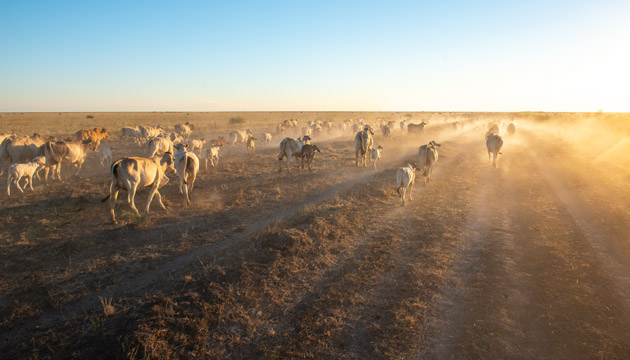Lance and Kylie Hutley have built a successful cattle business on Heytesbury’s Birrindudu station, based around calm cattle and a family atmosphere for staff.
Story + Photos Ken Eastwood
Bands of colour stretch to the horizon in abstract curls and swirls. A wash of gold from the east streaks across dark-green braids plaited through a base of bluebush. Under the R22 mustering chopper, the rich palette of Birrindudu station morphs to deep reds and oranges, with turkey mound reservoirs standing out like brilliant blue eyes and the lines of graded tracks drawing the human eye into the vast, flat canvas. Khaki coolibahs and turpentine give way as the landscape changes to the mainly treeless blacksoil country, its rich, yellow Flinders and Mitchell grasses studded with white Brahman forms.
As far as the eye can see, this is Birrindudu: a sprawling 6700-square-kilometre Northern Territory cattle station that takes in two leases (4150sq km Birrindudu and 2582sq km Wallamunga) on the edge of the Tanami Desert. Snug up against the Western Australian border, it nurtures some 27,000 head, part of the Heytesbury Cattle Company’s 160,000-strong herd across six properties.
Sturt Creek comes into view, its languorous line leading towards a spiralling dust plume on the horizon, clearly indicating where several hundred head are fenced in the home yards. There, station managers Lance and Kylie Hutley and their small team of seven are hard at work drafting weaners and processing cattle.
In an hour or so, Helimuster pilot Alex Bryant will start mustering a mob in a paddock 50km away. With no ground support, he’ll use the chopper to expertly direct hundreds of cattle into another set of yards.
Alex says that because the cattle on Birrindudu are so well managed, they are generally easy to muster. “These cows here they really run well,” he says. “You do get some run-backs from the weaners, but that’s pretty typical.”
Amid thick clouds of dust in the home yards, one thing is obvious. Surrounded by Brahman bulls up to 800 kilograms, and hundreds of cows, heifers, steers, weaners and calves, the team are quiet and calm, and so are the cattle. There are no dogs yapping at heels and no cattle prods in hands. Instead, there are smiles and laughter, and the station hands generally walk with the mobs, crooning a long, soothing call Lance has used all of his time on the land. “Oooooold cows,” they call. “Oooooold cows.” And, generally, the cattle stick their heads up and walk obediently to the race or wherever they are going next, with only the occasional beast causing a stir, or prompting someone to quickly climb the rails.
“If you’ve got mad cattle, it’s a workplace health and safety issue,” says Lance, between drafting calls. “I don’t care if it’s a $5000 bull; if it’s mad, it’ll go. We paint any now if they give us trouble when they come through, and when they come back in, if they carry on the same way, they’ll go to market.”
Working separately or together, Lance, 53, and Kylie, 46, have different styles. Lance is a steady rock, quieter and reserved in his praise, whereas Kylie is a rarely still bundle of energy, jumping onto bikes or into the truck, giving constant encouragement to the team, nearly all of whom only started working on Birrindudu at the beginning of the dry season and some of whom are very green. “Keep going around,” she calls to station hand Travis Fisher. “C’mon, you’re the boss.”
“Officially I’m manager, and she’s manager support,” Lance says, “but it’s the other way around. She says ‘jump’ and I say ‘how high?’ Kylie just makes it all enjoyable and she reads people really well and if she sees a problem she deals with it – she can’t sit still for five minutes.”
Kylie loves training new staff and calls all the station hands her ‘kids’. After just a few days of knowing her, they all call her Mum. “I’m not in there telling them what to do, I’m more teaching and training them,” she says. “Not many people like taking chances on under 18s, but if they’re passionate to learn, then you can actually mould them. I give them lots of cuddles, lots of openness and am working by their side day by day.”
The full version of this story was published in both OUTBACK magazine and the 2018 edition of our special one-shot magazine OUTBACK Stations.
This story excerpt is from Issue #122
Outback Magazine: December/January 2019










